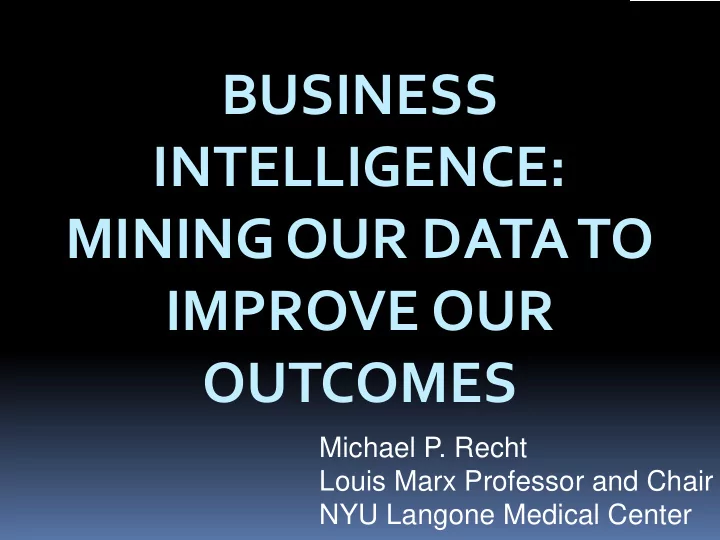

BUSINESS INTELLIGENCE: MINING OUR DATA TO IMPROVE OUR OUTCOMES Michael P. Recht Louis Marx Professor and Chair NYU Langone Medical Center
USING DATA TO CREATE VALUE To succeed, Imaging departments need to change and adapt to new environment and external pressures The only way to successfully do that is to collect, aggregate and analyze data And then to Change and https://www.pinterest.com/pin Adapt to what the data tells you
DATA Needs to be : Accurate Customizable
DATA Needs to be : “The issue is that companies don't create value by owning the latest Accurate technology, or by managing data Customizable access rights. …Value is created by putting data in the hands of business Accessible people (“radiologists”). Successful CIOs are moving to an Agile approach Transparent/ easily where technologists, data scientists understood and business people work in close Real time collaboration to focus the technology investments and analytical activities on the areas with the greatest potential to derive real, meaningful insights for the business.” Berez, Bain
DATA Needs to be : Accurate Customizable Accessible Real time Transparent/ easily understood Actionable http://smallbiztrends.com/2016/01
DATA “ 90% of the data you collect will never be actionable or even helpful.” Albert Einstein http://smallbiztrends.com/2016/01
DATA Data should not be punitive Group/section oriented rather than individual Take advantage of the Hawthorne effect Not a “report card” but a tool to allow everyone to be involved and improve
FIVE STAGE RESPONSE Denial Anger Bargaining Depression Acceptance
DASHBOARDS Customize for users Leadership Section heads/section members Admin Chief techs Billers/ Pre-cert
DASHBOARDS Volume Scheduled exams Performed exams Exams per day Historical trends
DASHBOARDS Quality On time starts Turnaround time Unread cases Radiation dose Enhanced imaging report Structured reporting Retake
DASHBOARDS Finance/admin Insurance payments by payer by modality Denial information AR Pre-certification data
DASHBOARDS Research/Education Grants NIH Non-NIH Mentors Tenure timelines Resident case logs
MR REENGINEERING Backlog Inpatients Pediatric Anesthesia On Time Performance Scan duration Exam volume
RESULTS Large number of patients not scanned on scheduled magnet – led to significant downstream delays Developed “electronic greaseboard” Tracked every step of patient experience Available on ipads and large screens Drag and drop
Results Outpatient anesthesia Moved slots to 7-11 every day and all day on Saturday Increased slots from 17 to 25 Changed hour of operations – more weekends and evenings Lack of standardization across sites/scanners Quality manager Enforced standard protocols by all radiologists Appropriately “timed” exams Technologists key to success –Best in Practice
RESULTS Increased # of techs per magnet Compared times with either 1 or 2 techs per magnet Average time saved/transition with 2 techs = 5 min 8 sec At 16 cases/day/magnet = 1 hr 22 min saved – allowed 2 more cases per day Regular follow up meetings Meet with MR “leadership” team biweekly
RESULTS 59% growth from 2013 to 2017 13% growth first quarter 2018
NEXT STEPS Increase duty cycle of scanners Decrease turnaround times between patients Dockable tables and dedicated prep rooms RTLS Machine “up Time” Service costs Scheduling Efficiency No shows/ Cancellations Same day add ons
SCANNER UTILIZATION
INTRASCANWORKFLOW
NEW MR CENTER Dockable tables Dedicated prep room 2 doors in and out of each MR scan room 1 directly connected to prep room Scanner angled to provide straight line to prep room Coils in prep room Key coils duplicated 3 techs per scanner
BENEFIT OF SPEED If save 5 minutes per exam # of # of scanners avg additional At 16 cases/day/magnet and an average of 40 in reimbursement avg days scans per increased revenue system per scan scanning day per year minutes per exam = 2 extra cases per day At $500 per case = $260,000 per magnet per year $ 45 500.00 260 1 $ 22,500.00 $ 5,850,000.00 $ 45 500.00 260 2 $ 45,000.00 $ 11,700,000.00 $ 45 500.00 260 3 $ 67,500.00 $17,550,000.00 $ 45 500.00 260 4 $90,000.00 $23,400,000.00
ULTRASOUND Typically 1 tech per room Exam slots 30 min Registration Changing US Room 21 min 18 min 20 min 22 min 19 min 21 min
ULTRASOUND Pilot 2 techs per room 20 minute room time Enables you to eliminate 1 room out of 3 or increase volume by 33% with same number of rooms Pilot demonstrated improved on-time performance Increased tech satisfaction
QUALITY Need to learn form our mistakes (“failures”) Book contrasts airline industry with radiology (mammography) How do we get feedback (data) about our performance
QUALITY- RAD-PATH CORRELATION
QUALITY- RAD-PATH CORRELATION
RAD-PATH CORRELATION Approximately 5000 per month Now expanded to OR notes Goal is to discover systematic trends rather than anecdotal or individual's errors Peer Learning vs Peer Review Approx 150 learning opportunities per month Each section working on research project based on results Now extended to pathologists
SUMMARY Data needs to be Accurate Transparent Non-threatening Actionable “Without a goal, analytics is aimless and worthless ” Michael Porter
Recommend
More recommend